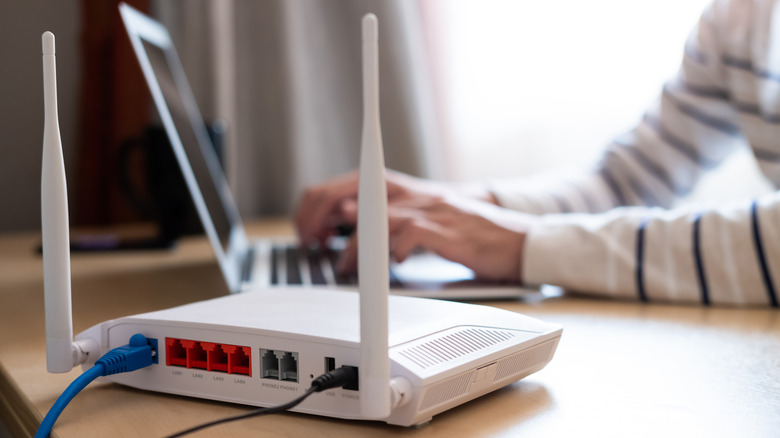How To Access Your Router's Parental Controls
As is the case with most digital platforms, parental controls are a great way to filter out content you might not want your children to see. While most modern software platforms offer parental controls, they can't catch everything. That's why some routers offer parental controls, too: it's another layer of protection. In fact, the smart thing to do is to set up parental controls on your devices alongside parental controls on your router. The biggest difference between device-level parental controls and router-level locks is that device-level protection can be more specific versus a general block at the network level.
Parental control isn't just for kids, either. If there is certain content you don't want to see, parental controls are a great way to block certain content entirely not only from yourself but also from anyone who joins your home Wi-Fi network. For example, you may not be a big fan of mature content. With parental controls enabled at the network level, you can ensure mature content never shows up in your home regardless of who is connected to the Wi-Fi.
How to access a Wi-Fi router's parental controls
Many modern routers have an app that you can download, making them much more user-friendly and their settings easier to access. Typically, when your router has an app, you just need to go into it and tap on the settings options — in this case, the feature will usually be labeled as parental controls. It's worth noting that not all routers have parental controls built-in; sadly, there's not much you can do about that outside of buying a new router. If your budget doesn't allow for that, you can try to enable parental control options individually for all of your devices instead. Most devices have robust parental control options, such as the iPhone and iPad, both of which pack Apple's Screen Time app that features parental control and content restriction options.
For more traditional or older routers (and sometimes even modern routers), you'll need to enter the router's IP address in your web browser in order to access its settings. That IP address varies by the router model but can typically be found on the router itself or its original box; it's usually a variation of 192.168.0.1, 192.168.1.1, or 10.0.0.1. From there, you'll need to provide your username and password. Those should also be printed on your router somewhere, but the info may instead be on the box it came with. Most routers' default username is "admin" and the password is typically either "admin" or "password" — though, in some cases, the password is blank and you can simply hit the Enter key after entering the default username. Of course, for security's sake, we recommend you change the password from its default setting once you've logged in.
Setting up a Wi-Fi router's parental controls
While we, unfortunately, can't offer a one-size-fits-all guide on how to enable parental control features, we can offer some help. Routers come in all different shapes and sizes and likewise pack different operating systems and user interfaces, meaning the exact menus in which these settings are found may go by many names. As a general rule of thumb, parental controls are typically found under either a "Firewall," "Tools," or "Advanced Settings" tab. The menu is generally the same regardless of whether you're trying to access your router via a browser or through an app.
If you have an Xfinity router, the Parental Controls tab is available as soon as you sign in via the web browser (via Xfinity). Comcast's system allows you to block sites and keywords in addition to setting a schedule for when these blocks come into effect. Another common router is the eero router, which is controlled directly through an app on your smartphone or tablet. Eero works slightly differently from other major routers. In addition to blocking certain websites or categories, eero also lets you pause internet access to certain devices or pause internet access for the entire network. This is handy if you're trying to have a distraction-free breakfast or want to ensure your kids are in bed asleep and not secretly browsing their phones all night.
What to do if your router lacks parental controls
If your router doesn't have parental controls, your task will be a bit more difficult, as you'll need to configure parental controls at the device level instead. The upside is that this also means the parental controls won't be network-specific, so the filters are still applied even if the device isn't on your home Wi-Fi network.
When it comes to smartphones and tablets, it's pretty straightforward. Both iOS and Android have extensive parental control options. The same goes for Mac and Windows. Gaming consoles like the Nintendo Switch, PlayStation 5, and Xbox Series S|X most definitely have very strict and comprehensive parental control options (via ESRB) — and sometimes it's not even a content thing. Especially with gaming consoles, parental controls can be handy to limit the amount of money your kids spend.
Device-specific parental controls are often more extensive and cater to the specific platform anyway, so they may be a better option for you than router controls. For example, as outlined by Apple in a support document, the company offers you the ability to restrict movies and TV shows past a certain rating from even showing up when you're browsing or searching. Or if you're using parental controls on your kids' Nintendo Switch, you can limit the amount of time they're allowed to spend in a game or overall, and limit what genres of games are made available to them (via Nintendo).



